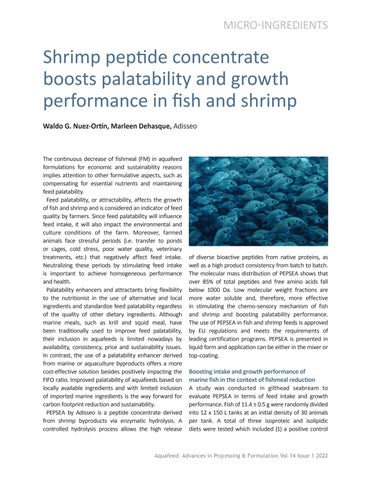MICRO-INGREDIENTS
Shrimp peptide concentrate boosts palatability and growth performance in fish and shrimp Waldo G. Nuez-Ortín, Marleen Dehasque, Adisseo
The continuous decrease of fishmeal (FM) in aquafeed formulations for economic and sustainability reasons implies attention to other formulative aspects, such as compensating for essential nutrients and maintaining feed palatability. Feed palatability, or attractability, affects the growth of fish and shrimp and is considered an indicator of feed quality by farmers. Since feed palatability will influence feed intake, it will also impact the environmental and culture conditions of the farm. Moreover, farmed animals face stressful periods (i.e. transfer to ponds or cages, cold stress, poor water quality, veterinary treatments, etc.) that negatively affect feed intake. Neutralizing these periods by stimulating feed intake is important to achieve homogeneous performance and health. Palatability enhancers and attractants bring flexibility to the nutritionist in the use of alternative and local ingredients and standardize feed palatability regardless of the quality of other dietary ingredients. Although marine meals, such as krill and squid meal, have been traditionally used to improve feed palatability, their inclusion in aquafeeds is limited nowadays by availability, consistency, price and sustainability issues. In contrast, the use of a palatability enhancer derived from marine or aquaculture byproducts offers a more cost-effective solution besides positively impacting the FIFO ratio. Improved palatability of aquafeeds based on locally available ingredients and with limited inclusion of imported marine ingredients is the way forward for carbon footprint reduction and sustainability. PEPSEA by Adisseo is a peptide concentrate derived from shrimp byproducts via enzymatic hydrolysis. A controlled hydrolysis process allows the high release
of diverse bioactive peptides from native proteins, as well as a high product consistency from batch to batch. The molecular mass distribution of PEPSEA shows that over 85% of total peptides and free amino acids fall below 1000 Da. Low molecular weight fractions are more water soluble and, therefore, more effective in stimulating the chemo-sensory mechanism of fish and shrimp and boosting palatability performance. The use of PEPSEA in fish and shrimp feeds is approved by EU regulations and meets the requirements of leading certification programs. PEPSEA is presented in liquid form and application can be either in the mixer or top-coating.
Boosting intake and growth performance of marine fish in the context of fishmeal reduction A study was conducted in gilthead seabream to evaluate PEPSEA in terms of feed intake and growth performance. Fish of 11.4 ± 0.5 g were randomly divided into 12 x 150 L tanks at an initial density of 30 animals per tank. A total of three isoproteic and isolipidic diets were tested which included (1) a positive control
Aquafeed: Advances in Processing & Formulation Vol 14 Issue 1 2022










